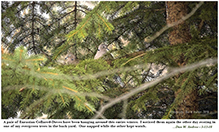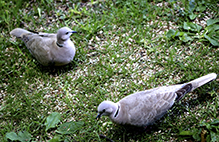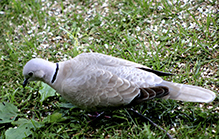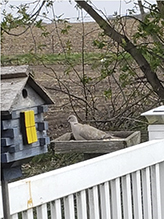Eurasian Collared-Dove
(Streptopelia decaocto)
Conservation • Description • Habitat • Ecology • Distribution • Taxonomy
|
|
||||||||||||||
Description |
The upper parts are very pale brownish-gray. There is a black collar on the back of the neck. The tail is square. |
Size |
11¾″ to 12½″ in length 22″ wingspan |
Voice |
Similar Species |
Mourning Dove (Zenaida macroura) is slightly smaller. The upper plumage is darker. The underparts are washed with pink. The wings have dark spots. There is no black collar on the back of the neck. The tail is long-tapered. |
Habitat |
Open deciduous woodland, shrubland, desert, old fields, and around human habitation |
Ecology |
Migration |
|
Nesting |
|
Food |
|
Distribution |
Nativity |
Europe, western Asia, the Middle East, Korea, and the Indian subcontinent |
Occurrence |
Uncommon in Minnesota |
Maps |
The Minnesota Ornithologists’ Union All Seasons Species Occurrence Map |
Taxonomy |
|
| Class | Aves (Birds) |
Order |
Columbiformes (pigeons and doves) |
Family |
Columbidae (pigeons and doves) |
Subfamily |
Columbinae |
Genus |
Streptopelia (turtle-Doves and collared-Doves) |
The current subdivision by many of the family Columbidae into five subfamilies has been shown by DNA analysis to be incorrect. For this reason, most sources do not include the subfamily when listing the taxonomic tree for doves. |
|
Subordinate Taxa |
|
Burmese Collared-Dove (Streptopelia decaocto xanthocycla) Eurasian Collared-Dove (Streptopelia decaocto decaocto) |
|
Some sources (Handbook of the Birds of the World) treat Burmese Collared-Dove (Streptopelia decaocto xanthocycla) as a separate species, Streptopelia xanthocycla. |
|
Synonyms |
|
|
|
Visitor Photos |
||
Share your photo of this bird. |
||
This button not working for you? |
||
Lisa Hoover |
||
a group of 6 hanging out the last couple of weeks |
||
 |
|
|
ABaker |
||
| Saw these for the first time in December of 2017. Didn’t know what they were. So fun to have new neighbors. These are several pair in the area. | ||
Dan W. Andree |
||
Kind of cute. Even though non-native... |
||
 |
|
|
Richard Thrasher |
||
A pair of Eurasian Collared Dove's are nesting nearby and visiting the area under our bird feeders |
||
 |
||
MinnesotaSeasons.com Photos |
||
|
||
|
||

Slideshows |
|

Visitor Videos |
||
Share your video of this bird. |
||
This button not working for you? |
||
Avi Birds |
Eurasian Collared Dove [Streptopelia Decaocto] |
About
In this video, we learn about the Eurasian collared dove. |
Other Videos |
||
| Eurasian Collared-Dove pwalpar |
About
Published on May 8, 2014 Video of two types of Doves together at my bird Bath. The Eurasian Collared Dove and the Mourning Dove. Check out these links to learn the differences. Eurasian...https://www.youtube.com/redirect?q=http%3A%2F%2Fwww.allaboutbirds.org%2Fguide%2Feurasian_collared-dove%2Fid&redir_token=Z-I5BNXkqh5WF3LjD2vNeehAwUt8MTQ5ODU4MDUzMUAxNDk4NDk0MTMx and the Mourning Dove...https://www.youtube.com/redirect?q=http%3A%2F%2Fwww.allaboutbirds.org%2Fguide%2FMourning_Dove%2Fid&redir_token=Z-I5BNXkqh5WF3LjD2vNeehAwUt8MTQ5ODU4MDUzMUAxNDk4NDk0MTMx |
| Eurasian Collared-Dove calling naturalist97333 |
About
Published on Jun 24, 2009 The dove calls for a while until a cranky Western Wood-Pewee chases the dove from his perch. |
| Eurasian Collared Dove Documentary pwalpar |
About
Published on Mar 11, 2009 This is a Documentary about the Eurasian Collared Dove, which is recient years has been spreading all over the United States. These birds are not native to the America's. Introduced into the Bahamas in 1975. They are spreading across the country. |
| Eurasian collared dove or Collared dove or (Streptopelia decaocto) Shirishkumar Patil |
About
Published on Jan 4, 2015 The Eurasian collared dove (Streptopelia decaocto), most often simply called the collared dove, also sometimes hyphenated as Eurasian collared-dove, is a species of dove native to Asia and Europe, and also recently introduced in North America.It is a medium sized dove, distinctly smaller than the wood pigeon, similar in length to a rock pigeon but slimmer and longer-tailed, and slightly larger than the related turtle dove, with an average length of 32 cm (13 in)[7] from tip of beak to tip of tail, with a wingspan of 47–55 cm (19–22 in), and a weight of 125–240 g (4.4–8.5 oz). It is grey-buff to pinkish-grey overall, a little darker above than below, with a blue-grey under wing patch. The tail feathers are grey-buff above, and dark grey tipped white below; the outer tail feathers also tipped whitish above. It has a black half-collar edged with white on its nape from which it gets its name. The short legs are red and the bill is black. The iris is red, but from a distance the eyes appear to be black, as the pupil is relatively large and only a narrow rim of reddish-brown iris can be seen around the black pupil. The eye is surrounded by a small area of bare skin, which is either white or yellow. The two sexes are virtually indistinguishable; juveniles differ in having a poorly developed collar, and a brown iris.Collared doves typically breed close to human habitation wherever food resources are abundant and there are trees for nesting; almost all nests are within 1 km (0.62 mi) of inhabited buildings. The female lays two white eggs in a stick nest, which she incubates during the night and which the male incubates during the day. Incubation lasts between 14 and 18 days, with the young fledging after 15 to 19 days. Breeding occurs throughout the year when abundant food is available, though only rarely in winter in areas with cold winters such as northeastern Europe. Three to four broods per year is common, although up to six broods in a year has been recorded.The male's mating display is a ritual flight, which, as many other pigeons, consists of a rapid, near-vertical climb to height followed by a long glide downward in a circle, with the wings held below the body in an inverted "V" shape. At all other times, flight is typically direct using fast and clipped wing beats and without use of gliding. The collared dove is not wary and often feeds very close to human habitation, including visiting bird tables; the largest populations are typically found around farms where spilt grain is frequent around grain stores or where livestock are fed. It is a gregarious species and sizeable winter flocks will form where there are food supplies such as grain (its main food) as well as seeds, shoots and insects. Flocks most commonly number between ten and fifty, but flocks of up to ten thousand have been recorded.The song is a coo-COO-coo, repeated many times. It is phonetically similar to the Greek decaocto ("eighteen"), to which the bird owes its zoological name. It also makes a harsh loud screeching call lasting about two seconds, particularly in flight just before landing. A rough way to describe the screeching sound is a hah-hah. Collared doves cooing in early spring are sometimes mistakenly reported as the calls of early-arriving cuckoos and, as such, a mistaken sign of spring's return.They are almost always seen in pairs and, like many birds, remain loyal to their mates. |

Visitor Sightings |
||
Report a sighting of this bird. |
||
This button not working for you? |
||
Lisa Hoover |
Location: Chatfield, MN a group of 6 hanging out the last couple of weeks |
 |
| ABaker 8/25/2020 |
Location: Kimball, MN Stearns County Saw these for the first time in December of 2017. Didn’t know what they were. So fun to have new neighbors. These are several pair in the area. |
 |
| Nate Hartwell 9/9/2017 |
Location: Naussa, MN Sighted many in western Minnesota and listened to their unique hoo-hoo, hoo coo in Naussa, MN where there were at least a dozen in town. Whatch for their square ended tail to differentiate from Mourning doves (pointed tail). The ring neck is only visible up close or with magnification. |
|
| Richard Thrasher 6/19/2017 |
Location: Green Isle, MN (Sibley County) A pair of Eurasian Collared Dove's are nesting nearby and visiting the area under our bird feeders |
 |
MinnesotaSeasons.com Sightings |
||
|

|
Created: 6/26/2017 Last Updated: © MinnesotaSeasons.com. All rights reserved. |

